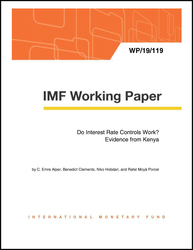
Do Interest Rate Controls Work? Evidence from Kenya
This paper reviews the impact of interest rate controls in Kenya, introduced in September 2016. The intent of the controls was to reduce the cost of borrowing, expand access to credit, and increase the return on savings. However, we find that the law on interest rate controls has had the opposite effect of what was intended. Specifically, it has led to a collapse of credit to micro, small, and medium enterprises; shrinking of the loan book of the small banks; and reduced financial intermediation. We also show that interest rate caps reduced the signaling effects of monetary policy. These suggest that (i) the adverse effects could largely be avoided if the ceiling was high enough to facilitate lending to higher risk borrowers; and (ii) alternative policies could be preferable to address concerns about the high cost of credit.
Publication date: May 2019
ISBN: 9781498313957
$18.00
Add to Cart by clicking price of the language and format you'd like to purchase
Available Languages and Formats
| English |
Prices in red indicate formats that are not yet available but are forthcoming.
Topics covered in this book
This title contains information about the following subjects.
Click on a subject if you would like to see other titles with the same subjects.
Lending rate cap , deposit rate floor , monetary policy , lend rate , small bank , SMEs , intermediation , CBK
Summary
Copyright © 2010 - 2024
Powered by:
AIDC



